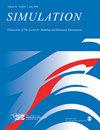Modeling and simulation of a multistage heat recovery steam generator
IF 2
4区 工程技术
Q4 COMPUTER SCIENCE, INTERDISCIPLINARY APPLICATIONS
Simulation-Transactions of the Society for Modeling and Simulation International
Pub Date : 2023-02-01
DOI:10.1177/00375497221130098
引用次数: 1
Abstract
As the share of renewable energy increases in modern power grids, their inherent intermittency compels existing thermal power plants to become more agile and flexible in their operation. To achieve such flexibility, understanding the transient behavior of thermal power plants is key. In this regard, physics-based dynamic models are useful tools. They help in predicting performance and in exploring various operating conditions in a risk-free, cost-effective manner. To this end, this paper presents a multi-stage Heat Recovery Steam Generator (HRSG) model. Fast simulations are demonstrated for this three pressure-stage system with interconnected thermodynamic and mass transfer phenomena. The HRSG’s multi-physics behavior is captured through mathematically modeled and numerically simulated phase change, fluid dynamics, and thermal coupling. Heat exchange elements such as economizers and superheaters are modeled by directly solving the Unsteady Flow Energy Equation (UFEE). The phase change dynamics of the boiler are modeled using a multi-mode switching mechanism, where each mode is characterized by boiling/evaporation/condensation and heating/cooling phenomena. A judicious combination of spatially discretized or lumped and dynamic or quasi-static models is used to achieve reasonably accurate transient response while lowering the computational burden. In collaboration with Siemens Energy Inc., steady-state prediction capability and transient pressure behavior are validated with plant startup data from an operational HRSG.多级热回收蒸汽发生器的建模与仿真
随着可再生能源在现代电网中所占份额的增加,其固有的间歇性迫使现有火电厂在运行中变得更加敏捷和灵活。要实现这种灵活性,了解火电厂的瞬态行为是关键。在这方面,基于物理的动态模型是有用的工具。它们有助于以无风险、低成本的方式预测性能和探索各种操作条件。为此,本文提出了多级热回收蒸汽发生器(HRSG)模型。对具有相互关联的热力学和传质现象的三压力级系统进行了快速模拟。通过数学建模和数值模拟的相变、流体动力学和热耦合,可以捕捉到HRSG的多物理场行为。采用直接求解非定常流能方程(UFEE)的方法对省煤器和过热器等换热元件进行建模。采用多模式切换机制对锅炉的相变动力学进行建模,其中每种模式都具有沸腾/蒸发/冷凝和加热/冷却现象的特征。将空间离散化或集总化模型与动态或准静态模型合理地结合起来,可以在降低计算量的同时获得较为精确的瞬态响应。通过与西门子能源公司的合作,通过运行HRSG的工厂启动数据验证了稳态预测能力和瞬态压力行为。
本文章由计算机程序翻译,如有差异,请以英文原文为准。
求助全文
约1分钟内获得全文
求助全文
来源期刊
CiteScore
3.50
自引率
31.20%
发文量
60
审稿时长
3 months
期刊介绍:
SIMULATION is a peer-reviewed journal, which covers subjects including the modelling and simulation of: computer networking and communications, high performance computers, real-time systems, mobile and intelligent agents, simulation software, and language design, system engineering and design, aerospace, traffic systems, microelectronics, robotics, mechatronics, and air traffic and chemistry, physics, biology, medicine, biomedicine, sociology, and cognition.

 求助内容:
求助内容: 应助结果提醒方式:
应助结果提醒方式:


